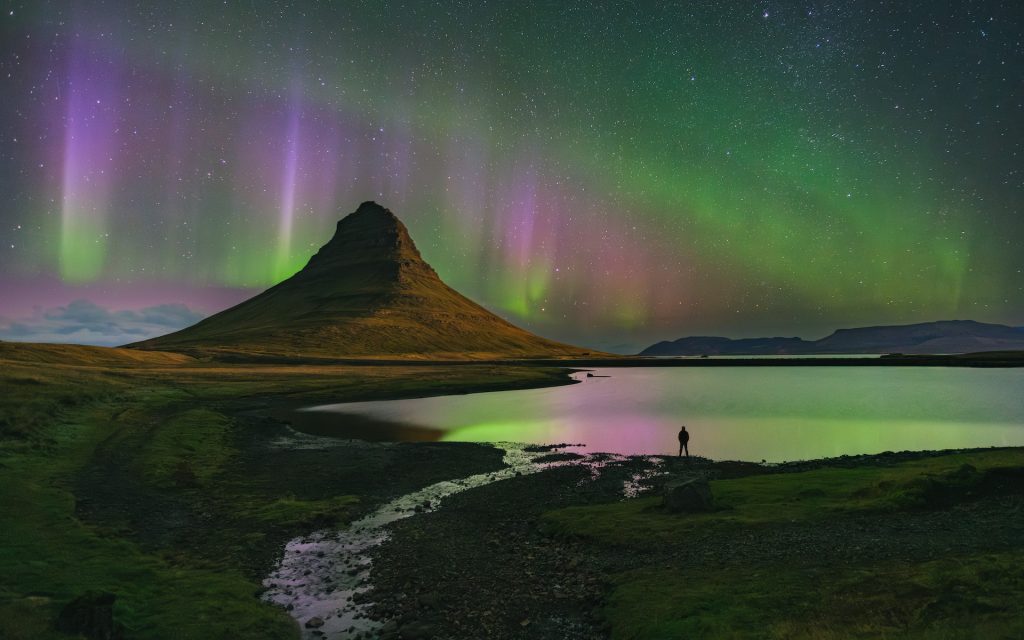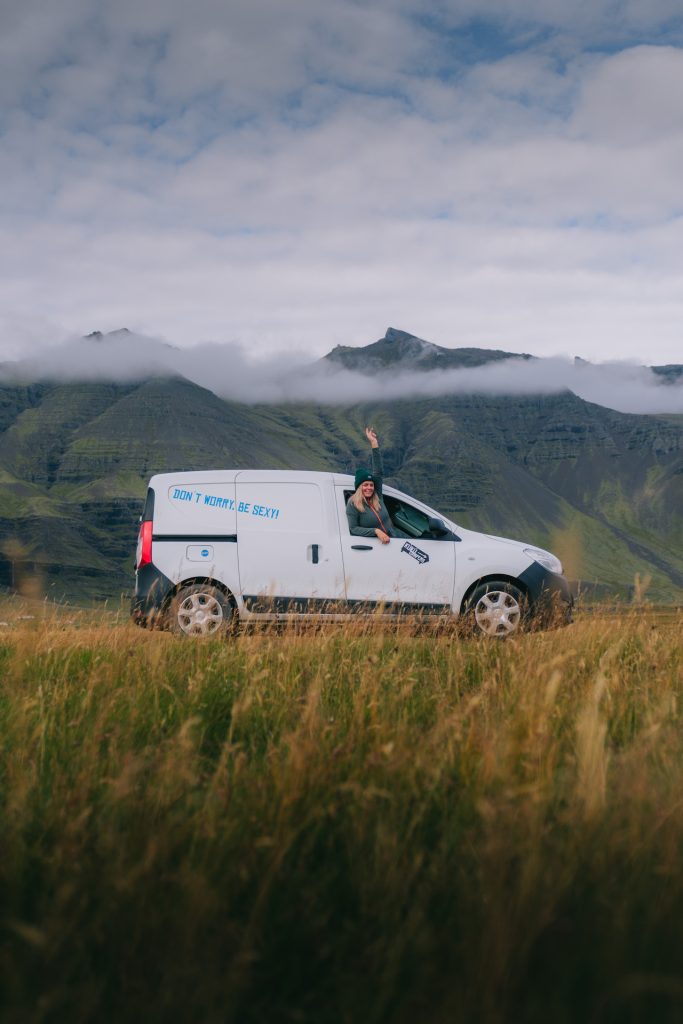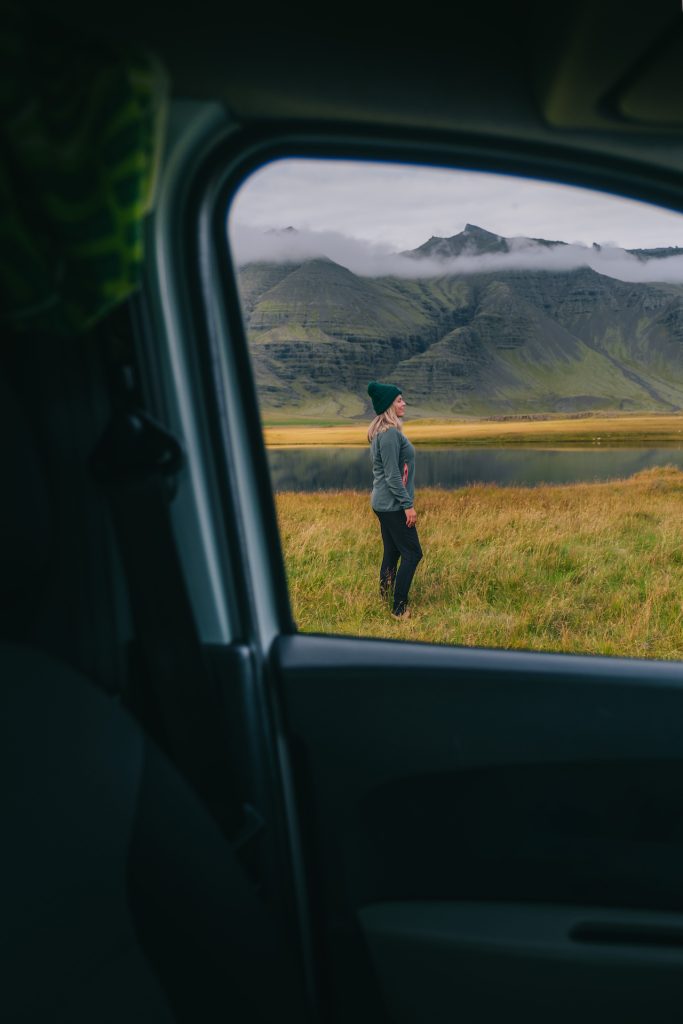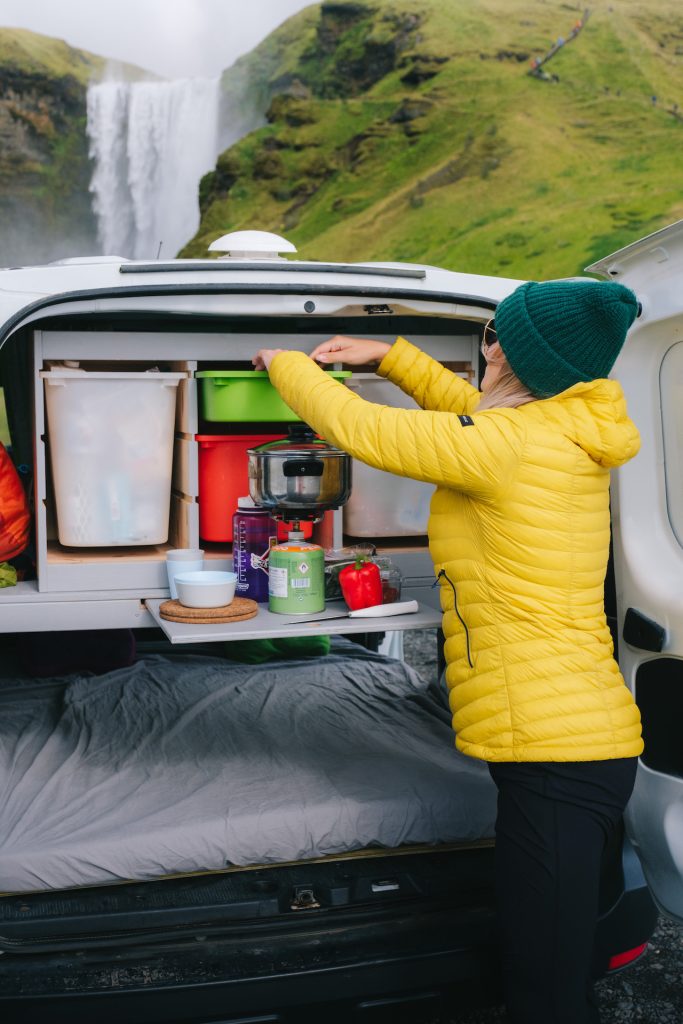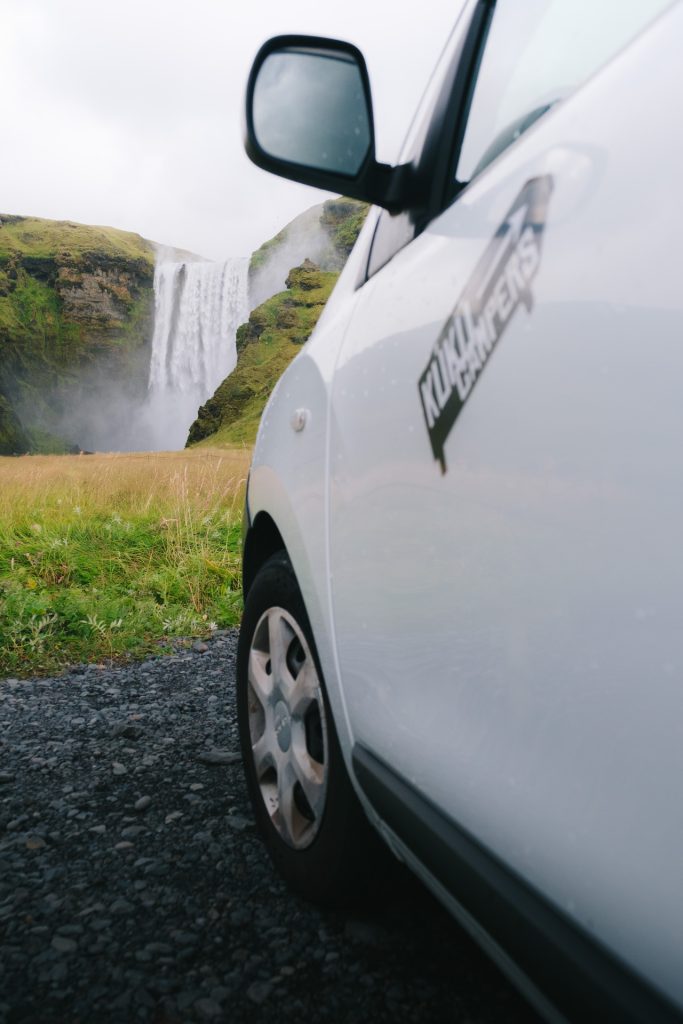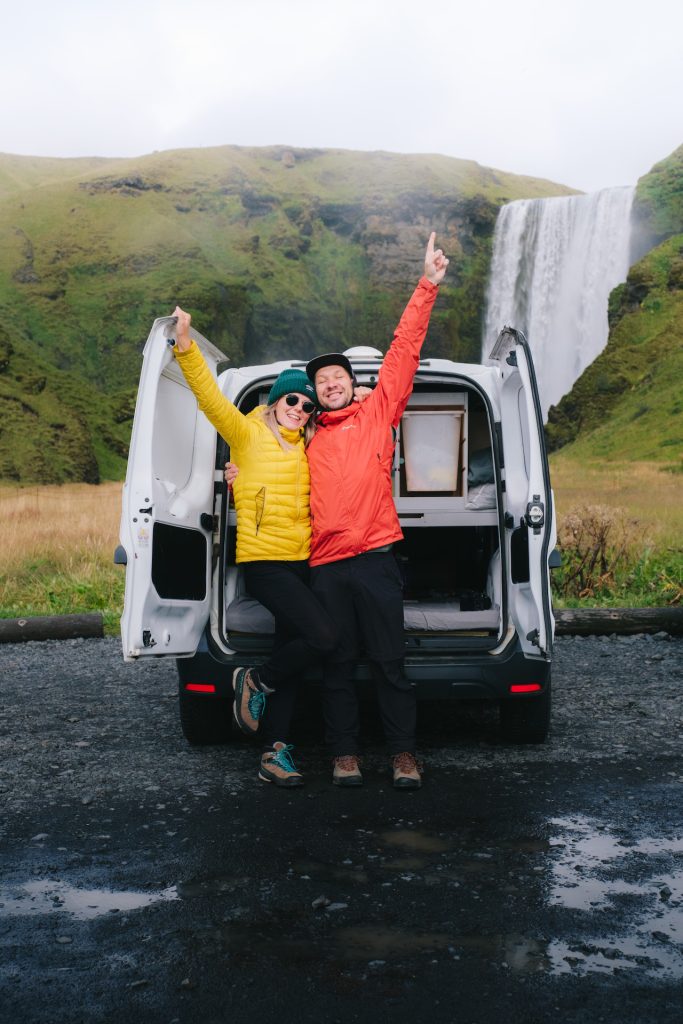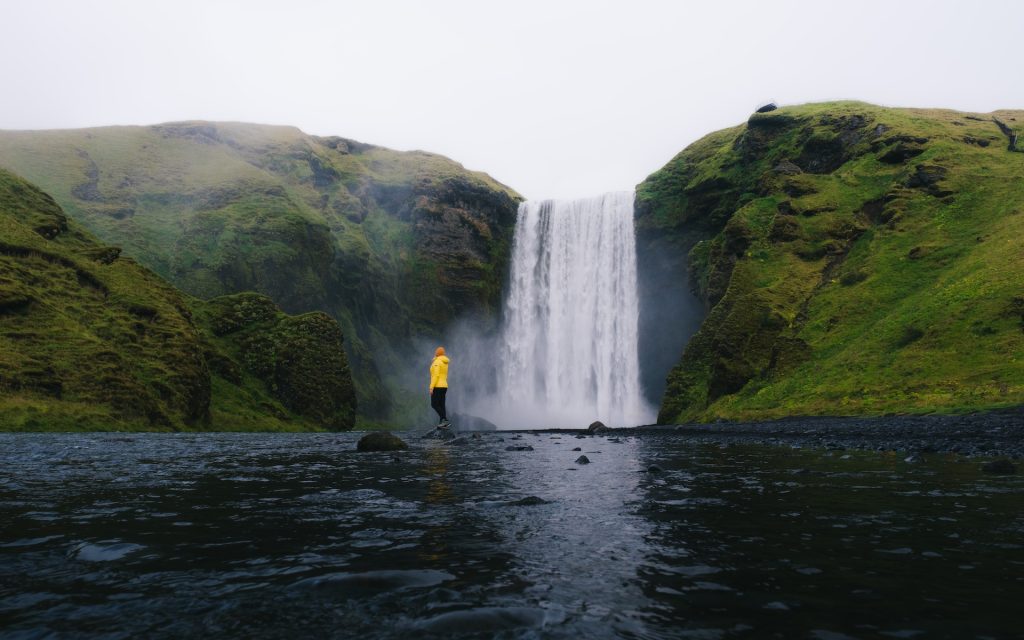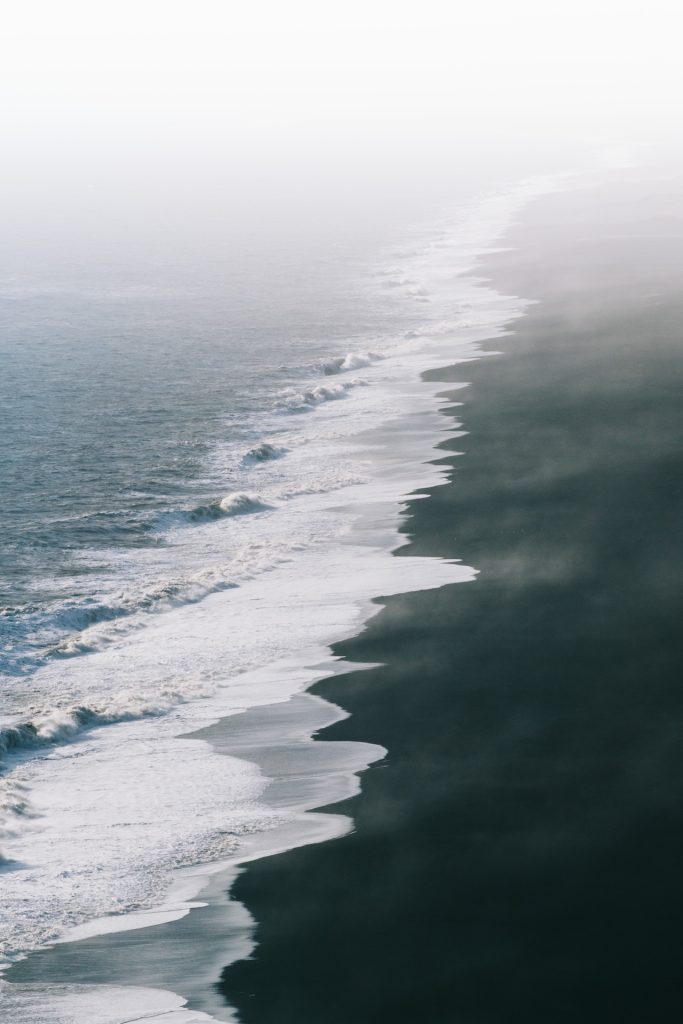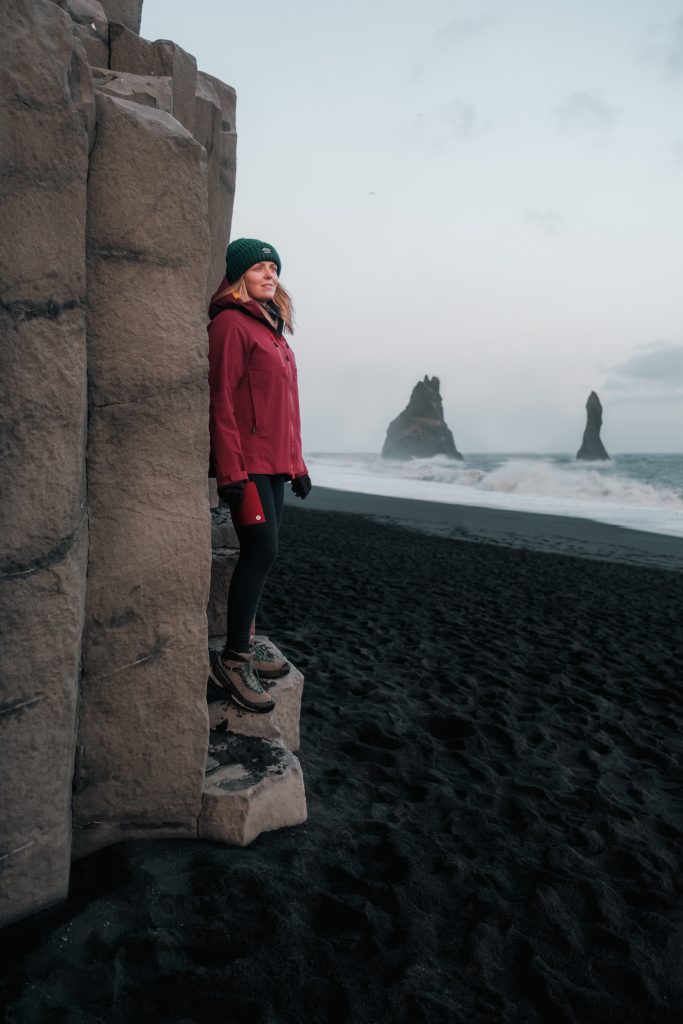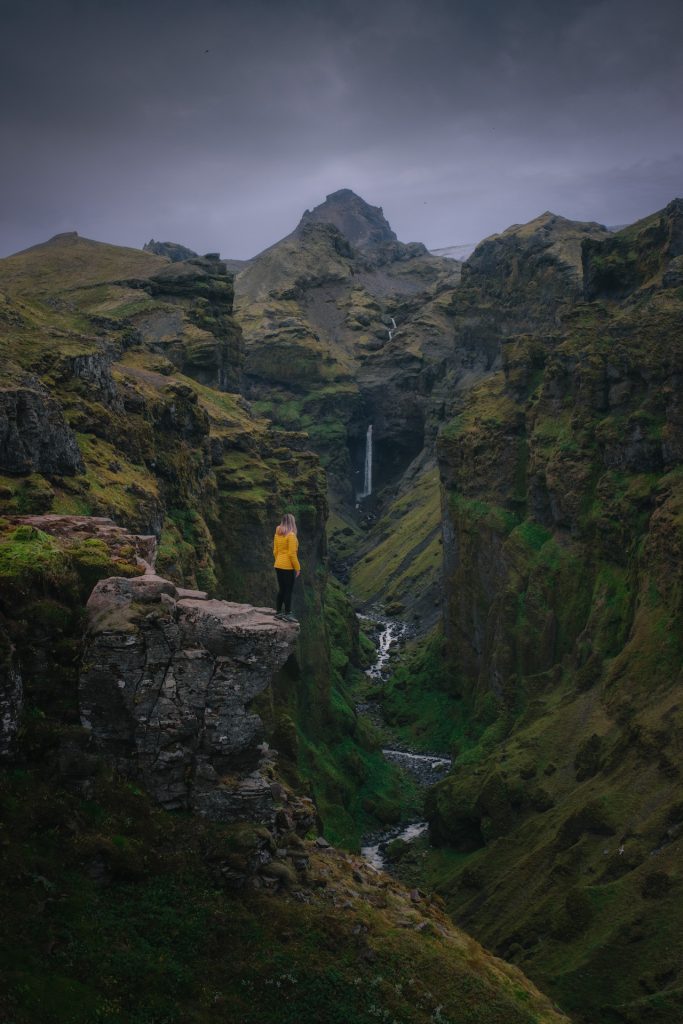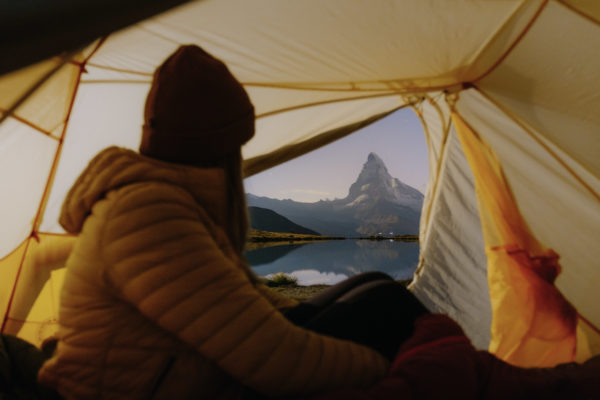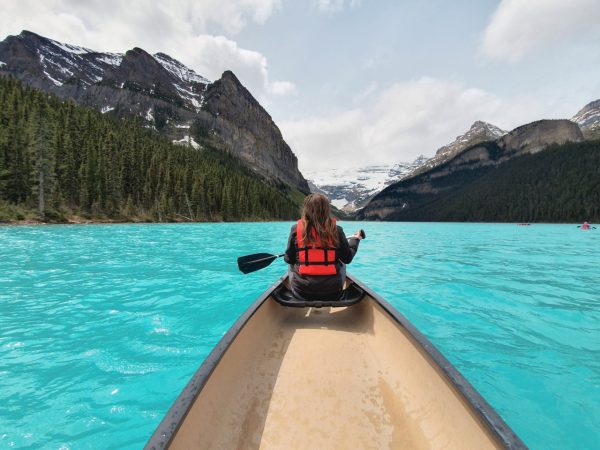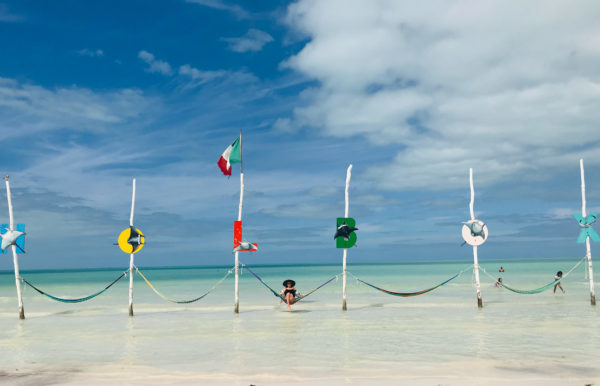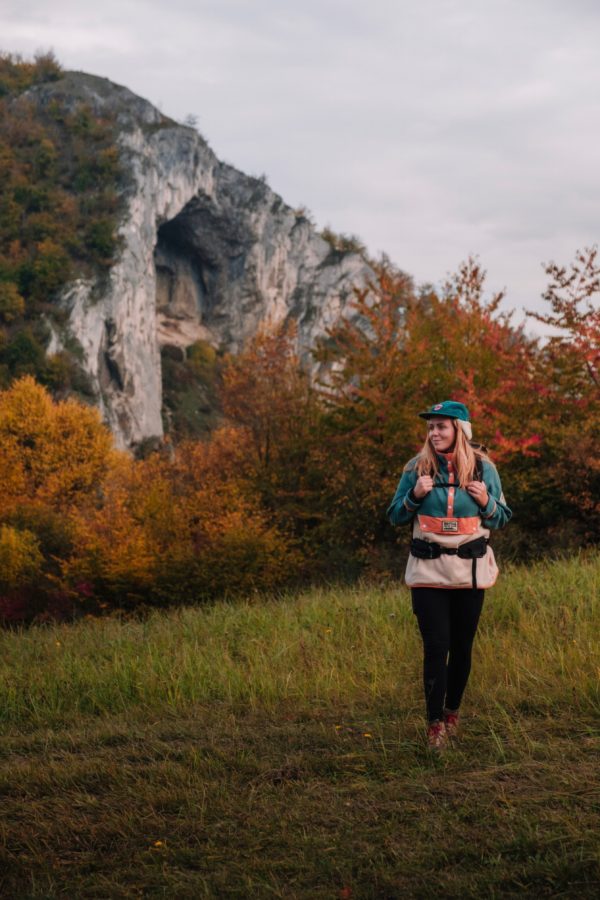Are you planning a trip to Iceland? Read my 10-day roadtrip itinerary and plan ahead! Whether you choose an adventure in campervan or a hotel these places will leave you breathless.
When is the best time to visit Iceland?
Well, it depends on your plans. If you wish to explore the famous Ring Road, you can choose any season you like. In spring, you can experience the lupin season and see puffin birds. In summer, you can also explore the Icelandic Highlands and enjoy more than 20 hours of daylight. During the winter months, there is a high chance of seeing the Northern Lights. We decided to visit Iceland in September when temperatures are still relatively mild, but there is a small chance of witnessing the Northern Lights.
Average temperatures in the summer range between 7°C and 12°C, but we also experienced -2°C on our last day, so be prepared for all kinds of weather conditions!
How to get around Iceland?
If you want to explore Iceland independently, you simply need to rent a car or a campervan. We chose to rent a campervan to have more flexibility, especially since hotels and Airbnb prices are quite high during the summer season.
We rented a campervan from Kukú Campers and traveled around Iceland in a Dacia Dokker minicamper. They had a great offer even during the peak season in Iceland. They offer vans of different sizes, all equipped with a bed and a small kitchen. You can also choose a van with a heater for added comfort. If you plan to explore the Icelandic Highlands, you’ll need to rent a 4×4 vehicle.
Renting a van gives you a lot of freedom to explore Iceland, but keep in mind that wild camping is illegal, so you should always look for official campgrounds. You can find a map of campsites HERE. While you don’t have to book them in advance, some popular spots can get crowded later in the evening.
Lastly, make sure you understand your insurance coverage and exemptions before starting your road trip.
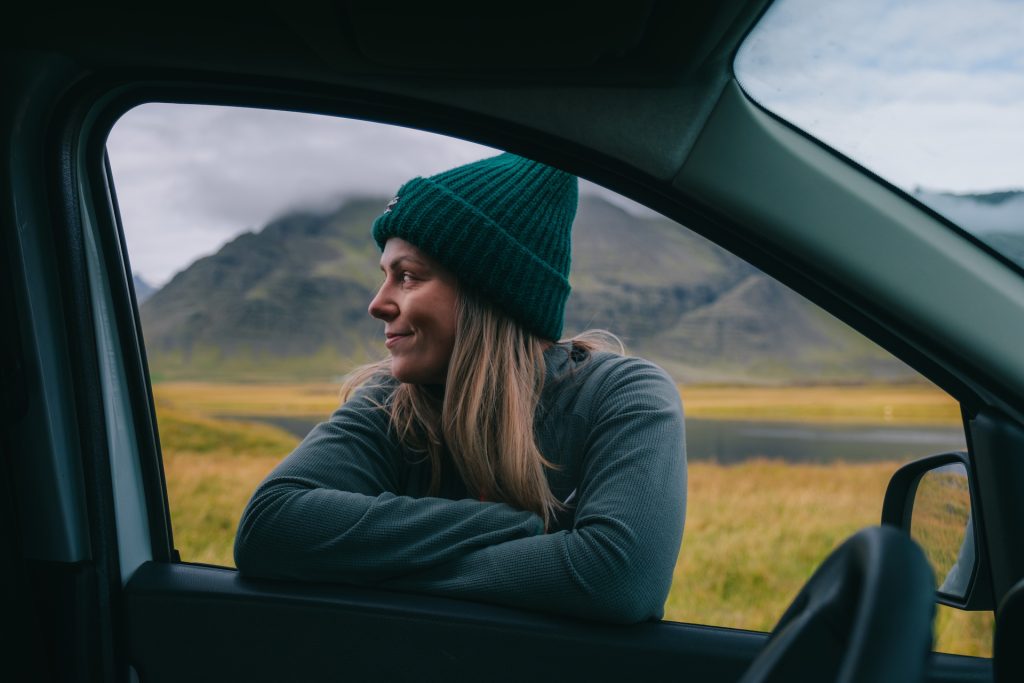
What is it like to drive in Iceland?
Speed limits are generally 30-50 km/h in populated areas, 80 km/h on gravel roads, and 90 km/h on paved roads. The Ring Road, also known as Road 1, is the main road that circles Iceland. F roads are unpaved roads that lead to the Icelandic Highlands. They are only open during the summer months and can be driven on only with a 4×4 vehicle.
Iceland has more sheep than humans, so be cautious, especially at the end of summer when sheep are being moved from higher altitudes to villages. Sheep often roam on the roads, and hitting one can result in a fine of up to €500.
Additionally, Icelandic law requires that your car lights be on at all times while driving. Be prepared for extreme weather; Iceland is known for its strong winds, even in the summer, which can cause car doors to fly open when you open them.
10 DAY Roadtrip Itinerary
Day 1:
Our flight landed in Keflavík, and we started our trip by picking up a minicamper. They offer a free shuttle service to and from the airport, which is only 5 minutes from their office. If you plan to travel to the Icelandic Highlands, you will need a 4×4 vehicle. However, we chose to explore the Ring Road, so we picked up a Dacia Dokker minicamper. Next, you’ll want to buy some groceries, and there are many budget supermarkets next to the office like Kronan or Bonus.
Seljalandsfoss and Gljúfrabui:
Our first stop was the stunning waterfall, Seljalandsfoss. It’s one of those waterfalls you can walk behind, so be sure to bring your rain jacket. Near this powerful waterfall is another hidden gem of Iceland called Gljúfrabui, located just 50 meters from the parking lot, hidden in a canyon.
Skógafoss:
One of Iceland’s wildest and most famous waterfalls, Skógafoss is a must-see. On sunny days, you can spot rainbows and birds, but it can get quite crowded with tourists.
TIP: If you have more time, consider hiking the Skógar Trail, which takes you further into the Icelandic Highlands and starts right at Skógafoss waterfall.
Campsite: You can spend the night at the campsite next to Seljalandsfoss or drive a bit further and stay at a campsite right in front of Skógafoss. The price is 1800 ISK per person, with an additional 400 ISK for a shower. There is no kitchen or common area, only toilets included in the price.
Day 2:
On our second day, we enjoyed breakfast with stunning views from our minicamper and continued down the Ring Road. Our next stop was the black sand beach, which was very windy, so we had to layer up.
Vík and Dyrhólaey:
Vík is one of the charming small towns in Iceland located next to a beautiful black sand beach. You can find picturesque views over the town from the hill next to the red church. A few kilometers from Vík is the Endless Black Sand Beach called Dyrhólaey where, on summer days, you can spot puffins and other bird species. We spent a whole day exploring Vík and the surrounding beaches.
Reynisfjara Beach:
One of the coolest places on this island, Reynisfjara Beach features black sand, unbelievable caves, structures, and massive black stones. We spent hours watching the massive waves. I recommend visiting Reynisfjara in the early morning to avoid crowds of tourists. Also, please exercise caution with the waves; sneaker waves can be dangerous. Read the hazards on the board and avoid getting too close to the ocean.
TIP: Be extra cautious with your car doors; this is one of the windiest places we experienced in Iceland.
Campsite: I recommend staying at the Vík campsite, which is very close to the coastline. The price is 1900 ISK per person and includes a dining area. Showers cost an extra 300 ISK, as is common at popular sites.
Day 3:
After buying some extra groceries and filling up our tank, we decided to travel further to visit the stunning canyon Fjadragljufur. Although we initially wanted to spend a night at the Thakgil campsite (which should be on your list!), we didn’t want to drive all the way back in the evening. So, we decided to skip it and sleep at a campsite next to Svartifoss.
Fjadragljufur:
To be honest, I didn’t enjoy visiting this beautiful canyon. It was very crowded, and the whole area felt overly touristy. However, we found a much more interesting place the following day.
Svartifoss:
It takes about an hour by car to reach the parking lot near Svartifoss from Fjadragljufur. This waterfall is surrounded by basalt columns similar to those at Reynisfjara Beach, formed from volcanic lava. The hike to Svartifoss is short, easy, and well-marked.
Campsite: If you prefer a slower pace and want to enjoy the views, stay at the Skaftafell campsite, which has all the necessary facilities but is slightly more expensive at 2500 ISK per person. We chose to drive further and stayed at the Svínafelli campsite, which includes a nice common room with a kitchen and showers. The price is 1800 ISK per person and includes a shower.
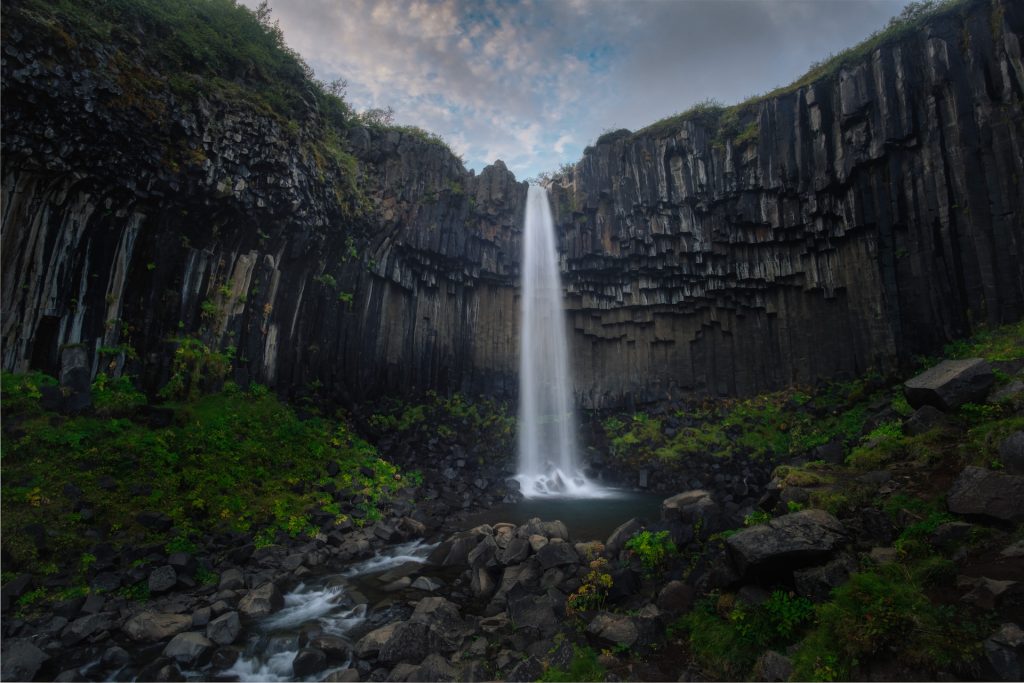
Day 4:
On this morning, we decided to drive straight to a hidden gem called Múlagljúfur, a place that will leave you speechless. Unlike many other popular spots in Iceland, Múlagljúfur remains relatively untouched by tourists.
You won’t find marked paths leading you to this stunning location; instead, you’ll need to park your car at THIS location and hike further up. The gravel road leading to the parking lot isn’t too challenging, but if you’re not driving a 4×4 vehicle, be extra cautious and drive slowly. The hike to the epic viewpoint takes less than an hour, but we spent much more time taking photos. This was one of the least crowded places we visited in Iceland. As we returned to our minicamper, it started pouring down with rain.
Campsite: Our next stop was supposed to be the Jökulsárlón glacier, but due to heavy rain, we wouldn’t have been able to see anything. So, we decided to return to the campsite Svínafelli, which was decent and less exposed to the wind. Unfortunately, in Iceland, you have to be prepared for many changes in your plans.
Day 5:
After almost 20 hours of rain, we decided to continue our journey to the glaciers. It was late in the afternoon, and we initially planned to visit Jökulsárlón and then head to Fjallsárlón and the famous Diamond Beach. We didn’t anticipate it would take us so much time!
Jökulsárlón:
This glacier lagoon is located very close to Fjallsárlón but is not as crowded. You can take a walk around the glacier or book a boat tour. Keep in mind that using drones over the glaciers is prohibited. Therefore, I recommend a boat tour to fully appreciate this Icelandic beauty.
Fjallsárlón:
Reserve at least 2-5 hours to explore this area. I highly recommend planning a full day trip to the glaciers. On a sunny day, this place will absolutely blow your mind. You’ll hike up from the parking lot and encounter glaciers of various colors and sizes.
Diamond Beach: You can also walk down to Diamond Beach, which tends to be very crowded. Tourists often sit on large pieces of ice to take numerous photos, but despite the crowds, this place is truly magical. The contrast between the black sand and ice creates a stunning contrast for photographers. We spent 2 hours walking down this beach, capturing photos and videos.
TIP: The amount of ice on the beach depends on the tide. Because of that, you might encounter a beach covered in ice or one with none at all.
Campsite: Our next stop was Vestrahorn and Stokksnes Beach, so we drove further and stayed at a campsite next to Viking Cafe. The price is 2000 ISK per person and includes admission to the beach. Yes, you have to pay an entrance fee for Stokksnes Beach, but the great thing is that you don’t have to pay extra for a hot shower, and you can stay until the afternoon.
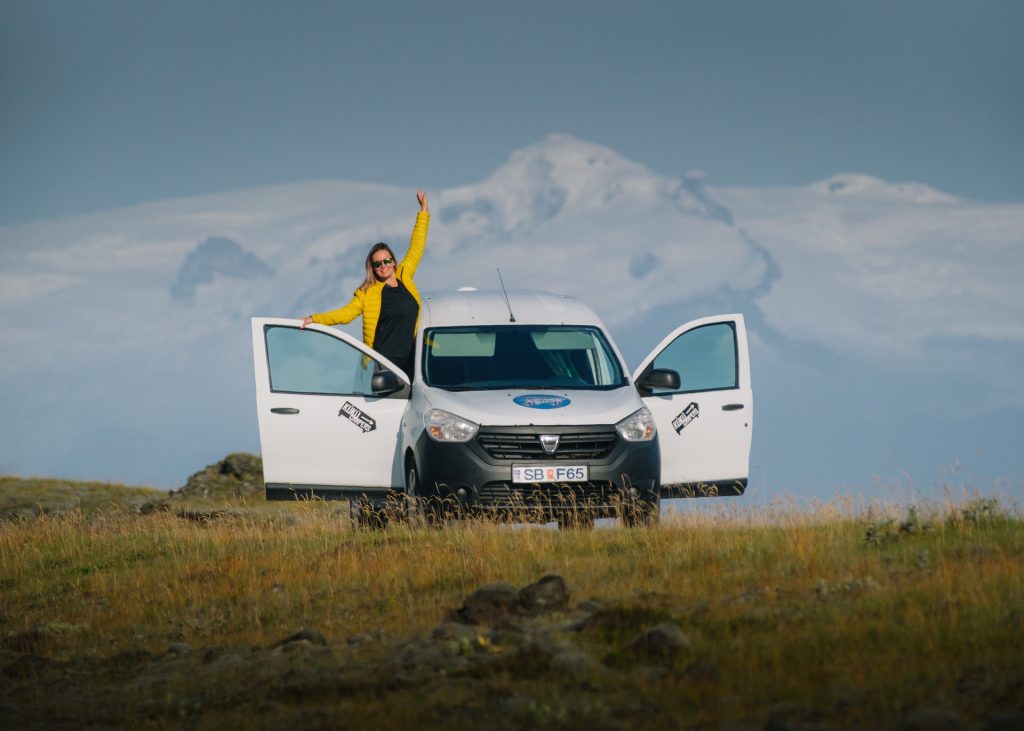
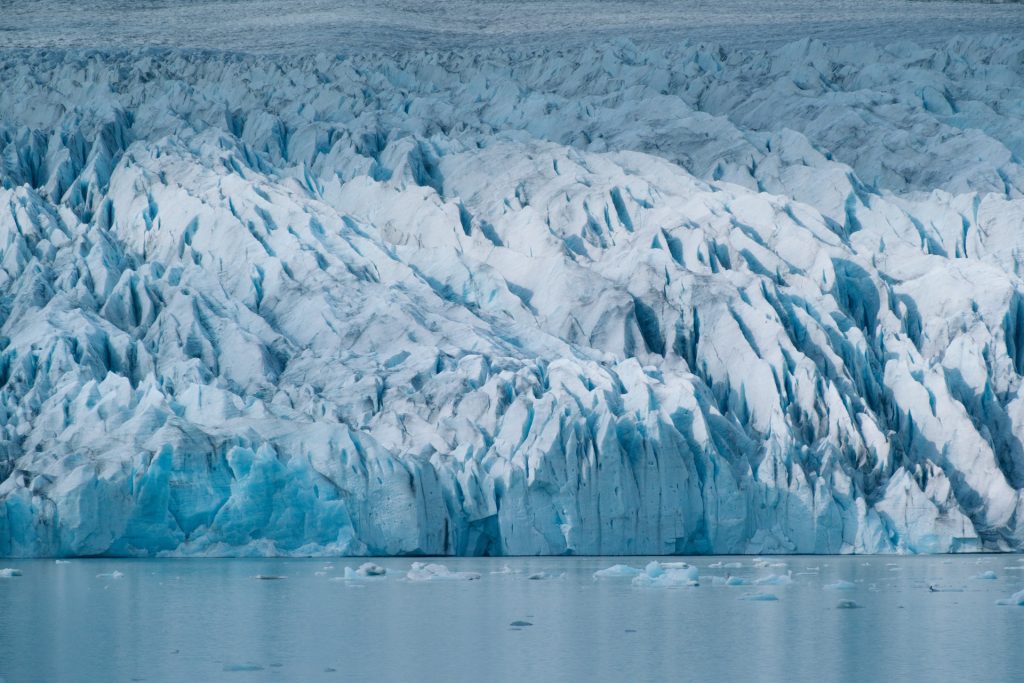
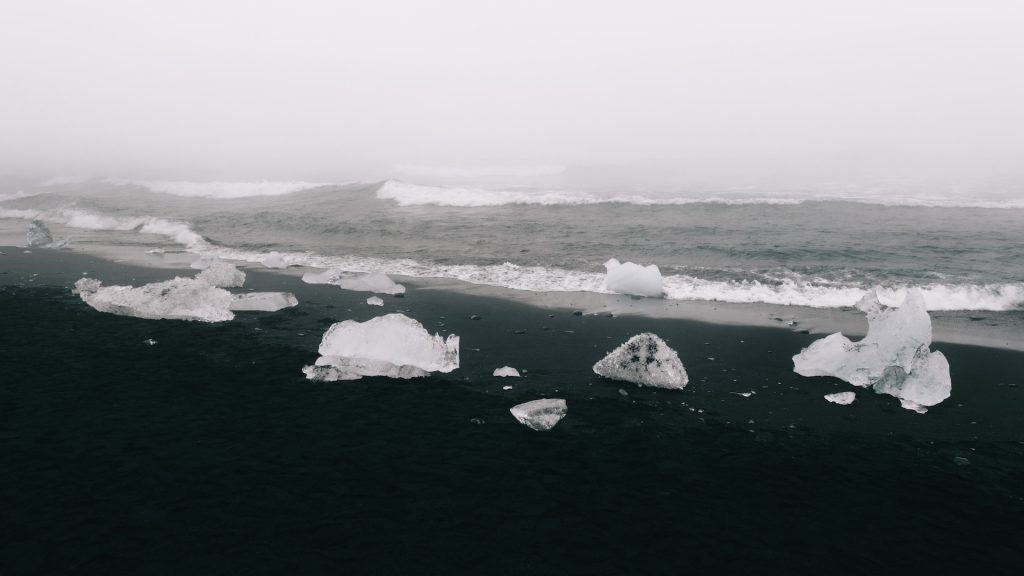
Day 6:
Our last day before heading back to the western part of Iceland was dedicated to Vestrahorn, also known for its beach called Stokksnes. You’ve probably seen this iconic mountain in many photos, but witnessing its jaw-dropping beauty depends on the weather.
Vestrahorn:
We parked our car next to Viking Cafe, which also serves as an official campsite with showers and toilets, although it lacks a common area or kitchen. Camping here includes admission to the beach, but you can only enter once (at least, that’s what they told us at the cafe). It can get extremely windy, so be sure to hold onto your car door when opening it. If you’re not camping here, the entrance fee is 800 ISK per person.
TIP: You’ll not only see the iconic mountain of Iceland but also a Viking village that was once used as a film set.
Campsite: On our way back, we decided to spend an extra night in the small town of Höfn. We needed to buy some groceries for the next few days, so we stayed at an official campsite for 2000 ISK per person, with an additional 300 ISK for a shower.
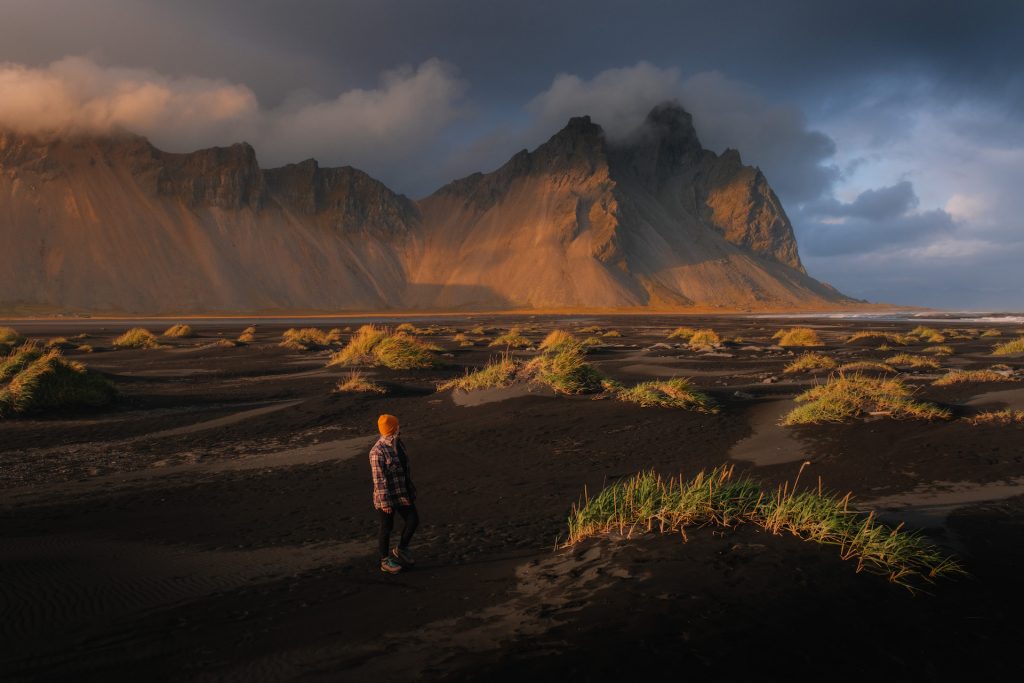
Day 7
Although we initially planned to complete the entire Ring Road, we decided to head back to the west because we were running out of time. Iceland is full of surprises, and exploring landscapes in extreme conditions, as we did on some of our days, might not be enjoyable.
Seljavallalaug Swimming Pool:
On our way back to Reykjavik, we made a stop at the Seljavallalaug swimming pool, an outdoor pool in southern Iceland located close to Skógafoss. Unlike other popular hot pools, there is no fee to visit and swim in this pool. There are no lifeguards, so you swim at your own risk. Note that the pool is not regularly cleaned and can be slippery. The hike from the parking lot takes about 15 minutes and is well worth it.
Campsite: We decided to spend the night in the town of Hveragerði at a large, quiet campsite for 2000 ISK per person, with no additional fees for facilities.
TIP: If you have more time, consider visiting the geothermal area in the town, which features numerous hot springs, or take a hike to Reykjadalur valley to swim in a hot river.

Day 8
As I mentioned earlier, because we visited Iceland in September, there was a chance we might see the Northern Lights. The best time to observe this solar activity is between September and April, and many of Iceland’s most stunning natural sites are great places to see the aurora borealis. One of those places is the Snæfellsnes Peninsula in the west.
Lóndrangar:
Snæfellsnes is a large peninsula extending from West Iceland. It took us three hours to drive from Hveragerði to the viewpoint called Lóndrangar. While most people visit Kirkjufellsfoss, there is so much more to explore on this peninsula. We made several stops along the way to admire the scenery, including horses, craters, and waterfalls. When you park your car, you’ll find a small pathway on the right side. Follow this road and hike down to the lighthouse for amazing views of the cliffs. That evening, we unexpectedly saw the Northern Lights despite somewhat cloudy skies. Therefore, we decided to drive further away from the light pollution. The next morning, we moved to the other side of the peninsula to Kirkjufell Mountain.
Campsite: We spent the night at the Arnarstapi campsite, which had clean and new sanitary facilities. The price was 2000 ISK per person, not including an extra 100 ISK per minute for a hot shower. There is a restaurant and cafe on-site.
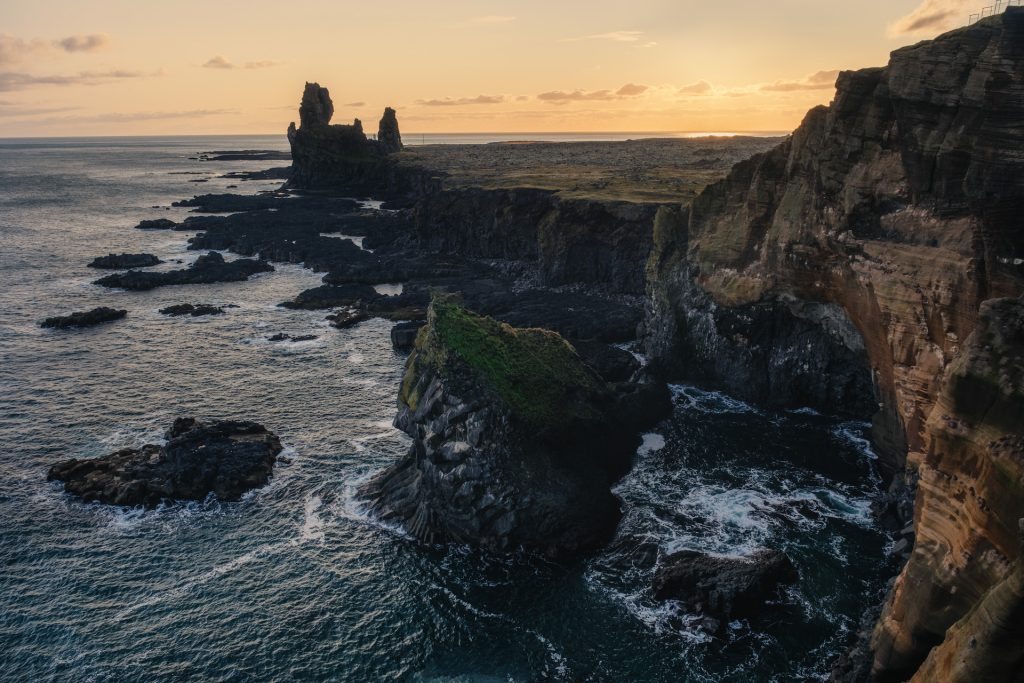
Day 9
We woke up to the sunniest morning of our entire stay in Iceland, had breakfast in our minicamper, and continued driving. As soon as we checked the weather forecast, we knew that the night would be perfectly clear, ideal for watching the Northern Lights. It was also my birthday and our last night in Iceland.
Kirkjufell Mountain:
On our last day, we headed to one of the most photogenic spots, and we spent the entire day there. Unfortunately, there’s often a line of photographers near waterfall Kirkjufellsfoss, and while the waterfall itself is stunning, the background makes it even more special.
Since it was my birthday, we decided to spend the afternoon and watch the sunset from a restaurant in the village of Grundarfjörður, right next to Kirkjufell Mountain. There’s only one restaurant in the town, and it can get very crowded, so don’t expect an extensive menu. You’ll find typical dishes like fish and chips, burgers, and perhaps two vegetarian options.
Northern Lights
After my birthday dinner, we returned to the parking lot in front of Kirkjufell Mountain and waited with high hopes. The Northern Lights appeared as soon as all the lights were gone. Around 10 PM, we witnessed significant aurora activity. It was a perfect birthday gift and a special moment on our last night. However, be prepared for very hostile weather; we experienced temperatures as low as -2°C on our last night.
Campsite: We spent the night in Grundarfjörður, but we didn’t even check all the facilities. It was the morning of our flight, so we had to drive back to the Kukú office.
On our 10th day we drove back to Kukú office where we checked the car and got a free shuttle to the airport. 🙂
